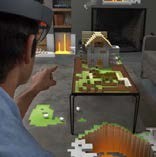A Virtual Walk Around Mars

By Merry Morris
There's no question that working on Mars is a hard gig. Just getting to work calls for a 180-day, one-way commute with no stops for Starbucks™. That is unless you will be investigating the red planet with the new Microsoft™ wearable technology, HoloLens, an augmented-reality headset and platform. Simply put, the HoloLens can project three-dimensional images into the air.
Microsoft and NASA's Jet Propulsion Laboratory have been jointly developing software that will allow researchers to move around Mars as if they were really there. Imagine being able to kick through the red Martian dust without leaving your office!
This sounds amazing and requires a bit of explanation.
Hololens Technology
There are three technologies working together that would make our virtual ramble on the red planet possible:
- Microsoft Holographic — an "augmented reality" platform that supports 3D imaging
- HoloLens — a wireless holographic computer headset for viewing and interacting with 3D images
- HoloStudio — an application that helps users create their own holograms
The attention-grabber, the wearable HoloLens, will have a transparent lens complete with advanced sensors, unencumbered by cords, wires, tethers or phones. The headset wearer will see a "smart" version of augmented reality set within a rectangular field hovering roughly six inches from his face. In that field, virtual images appear that remain in place so the user can approach, walk around or peer over them. A finger gesture can initiate interactions with the virtual objects, as can verbal commands.
Onsight, but Not on Site
A new technology called OnSight, the result of the collaboration between NASA and Microsoft, will enable scientists to explore the planet surface virtually. As part of that effort, composite images of the Mars surface were used to create a 3D mesh that allowed the user to walk around the study area. OnSight superimposes visual information and real rover data onto the HoloLens's rectangular field, where holographic computing generates a realistic environment for exploration, discussion, planning or other tasks that may arise as the rover continues its mission.
Virtual Opportunities for Gaming, Engineering Design and More
The future of the HoloLens technology is not limited to the NASA application. HoloLens can scan your surroundings so you can "live" your games, e.g., Minecraft, right in your own living room. HoloStudio gives the user an assortment of virtual shapes that can be assembled into an untold number of virtual objects - think toys, for example. Those virtual toys can then be used in 3D printing. Complex engineering designs can float before you as you tinker with their details.
Extension Questions
- Review the examples of the HoloLens in action from the company’s website.
- How would you use the technology to teach earth science, for example, in your classroom?